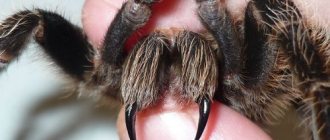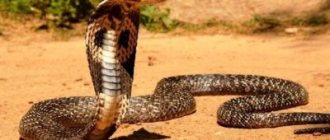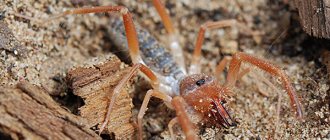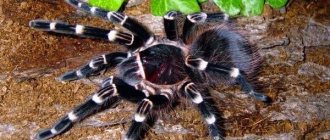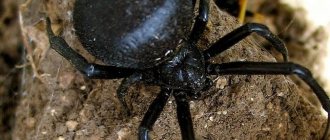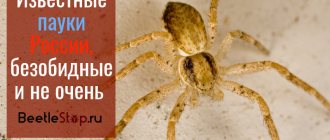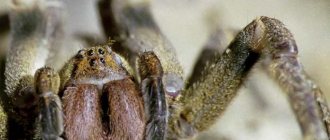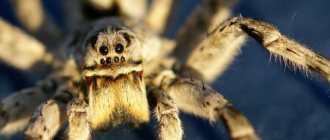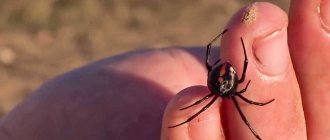Many people are afraid of spiders. But fear of them is not always just a phobia. Despite the fact that the northern Russian climate does not create ideal conditions for the life of insects and arachnids, the southern territories have everything necessary for their life and development.
There are spiders throughout the country that should be avoided and feared, as they can cause significant harm to human health. And even more than that, certain species can threaten life. It is worth considering the 5 most dangerous arachnids in order to remember them once and for all.
Where are poisonous spiders found in Russia?
Traditionally, Central Asia is considered the habitat of poisonous spiders. Sometimes - Middle and Central Russia. Rarely – Far East. But since the beginning of the 20th century, the boundaries of the ranges have become more blurred. People and goods travel from country to country, taking with them “stowaways.”
Thus, in the 21st century, 5 new species of spiders, uncharacteristic for the region, were noticed in Russia. The list includes:
- Pardosa laevitarsis from the Japanese wolf spider family;
- phycosome (Phycosoma labialis), or comb spider, living in China, Taiwan, Korea;
- zora (Zora lyriformis) - a spider from Eastern Europe and the Middle East;
- dwarf spider (Anguliphantes nasus) from Korea and China;
- funnel web spider (Allagelena opulenta), living in Japan and China.
Karakurt is the most poisonous spider in Russia. It is found in the desert regions of Kazakhstan, the steppes of Central Asia, Iran, and Afghanistan. It is found in Mediterranean countries, southern Russia and Ukraine. In 2010, karakurts appeared in the Saratov and Volgograd regions, which are uncharacteristic for the species. Therefore, there is no need to talk about the localization of poisonous arthropods in certain regions. It is more important to know why poisonous Russian spiders are dangerous and what to do if you encounter them.
General signs
As a rule, an ordinary spider has 6 pairs of limbs, but a person can notice only 4 pairs, since the organs of nutrition and touch are formed from the first 2 of them. The animal's body has 2 sections - the cephalothorax and abdomen, which are connected to each other by a thin bridge. If you carefully examine the spider, you will find that the cephalothorax also has a certain division into the chest and head parts using a thin groove. Limbs grow on the chest part, due to which the animal moves and weaves a web.
On the head of the spider there are:
- Chelicerae formed by the first pair of limbs.
- Pedipalps formed from the second pair of limbs. They serve for the spider both as an organ of touch and as a tool for catching and holding insects.
- Eyes.
- Oral apparatus.
The majority of species have 8 eyes, although the number of eyes depends on the habitat. So, spiders that live in caves where the sun's rays do not reach do not have eyes as such.
Karakurt
In total, 10 spiders are classified as conditionally poisonous in Russia. They make up the poisonous top 10. The most memorable of the top spiders and also the most poisonous spider in Russia is the karakurt. Characteristic black color. There are 13 red spots on the dorsal part of the abdomen.
Karakurt translated from Turkic means “black insect” (kara “black” + kurt “insect”). Kazakh legends say that the bite of this arthropod kills a camel. The spider lives in the steppes and desert regions of Central Asia, Ukraine, Russia, and the Mediterranean region. In Europe it is known as the “European black widow”.
View this post on Instagram
A post shared by Victor Ray (@v1cr4v)
The species Latrodectus tredecimguttatus belongs to the genus of black widows. It is considered aggressive, but only bites a person when it believes that the person is dangerous to the nest in which the egg sacs are located. It settles in places where garbage accumulates, including in street toilets. It is attracted by clusters of flies - the favorite prey of the black hunter. Therefore, people should avoid collecting cobwebs in sheds, basements and garages near openings. Karakurt settles in holes in the ground left by rodents, or in crevices.
Not lethal to humans. When bitten, a small amount of venom is injected, which feels like a pin prick. The person experiences muscle pain, chills, and nausea. A karakurt bite will be fatal only for those who are allergic to spider venom, i.e. for 5% of people.
Safe types
Safe species of spiders in Russia hunt insects, waiting for a long time for prey to fall into the net. Their bites are not dangerous for humans. These species live not only in nature; many live in courtyards and settle next to people in their homes.
Safe types of spiders in Russia include the following varieties:
- brownies;
- orb weavers;
- argiope;
- knitters.
People do not like spiders because in their homes they weave webs into hidden and visible areas of walls and ceilings. But in nature, creatures are beneficial and maintain the natural balance, so there is no need to fight them.
House spiders
This species prefers outbuildings and human habitation for its habitat. Preys on moths, bedbugs, cockroaches and other small insects. In nature, dense grass or a crack in tree bark serves as housing. The variety spreads evenly throughout Russia.
External signs of a house spider:
- the body is colored yellow with a brown tint; there is a brown pattern on the surface of the back;
- spider size is from 0.7 to 1.2 cm, females are always larger;
- The legs are colored darker than the body, their length is approximately 2 times the size of the body.
The web in dark areas of an apartment or house has the shape of a funnel. The owner waits for prey in the center of the net; when an insect hits, the spider deals with it with lightning speed.
Orb weaver in nature
The species lives in tree crowns, nets are placed between the branches, and the leaves are used to make shelters. Wheel-shaped traps immediately attract attention in a forest or garden. Sometimes round nets are placed under the eaves, in the window frames of abandoned houses.
The poison is toxic to invertebrates and small vertebrates; it affects rats, rabbits, mice, but horses, dogs, guinea pigs and sheep do not react to the bite. The locust's muscles lock up after 35 minutes, and the frog stops moving within 15 minutes. When bitten, a person experiences mild pain, but the volume of injected poison remains safe.
Orb weavers have an increased appetite and eat up to 8 insects at one time. If there is prey that is unacceptable to it in the trap, then the owner breaks off the web around it and the insect falls. It does network cleaning in the same way.
Argiope arthropods
Arachnids of this species are not dangerous to large mammals and humans. Males are modest in size and rarely exceed 0.5 cm, while females grow up to 2.5−3 cm. The color of the back resembles a wasp due to its bright black and yellow stripes. Short hair grows on the chest and partly on the head. The long legs consist of several jointed sections and are black with pale yellow spots.
Argiopes are spiders of central Russia, because they prefer areas with a temperate climate. They are also found in the southern part of the Stavropol Territory. The bite of an arthropod is compared to that of a bee; spiders do not attack first and do not show aggression. A slight pain is felt at the site of the lesion, swelling appears, but everything returns to normal after 2-3 days.
Trudoviks knitters
The species is distributed throughout the Russian territory and is found more often than in other countries. They almost always prefer nature and do not live in buildings. For hunting, round nets with large rectangular cells are made. The observer sees that such a product is not suitable for fishing due to the rare threads, but it’s all about the specific victim that must fall into the net. Knitters hunt for long-legged mosquitoes, which are a favorite delicacy.
Knitter Description:
- the body has an oblong shape;
- long legs consist of segmented segments;
- many outgrowths are observed on the chelicerae;
- females are large, reaching 3 cm, but males are inferior in height.
The long body saves the knitter in case of danger. At a moment of anxiety, he stretches his legs along his body and in this position resembles a dry twig. If it is disturbed in this state, the spider quickly falls and quickly runs away.
False black widow (steatoda)
The name "false black widow" indicates that its bearer is similar to the said spider. The false widow has a rounded abdomen of a dark color - from brown to black. Only the spots are not red, but pale light brown or another shade.
View this post on Instagram
A post shared by Victor Ray (@v1cr4v)
Steatoda grossa is harmless to humans. They weave nets 1.5 m above the ground to hunt insects. Closer to cold weather, spiders move to warm rooms - to home kitchens, greenhouses or greenhouses, and rarely to city apartments. As for its distribution area, the false black widow is cosmopolitan. Lives in North America, Australia, Europe. In recent years it has also been found in Russia.
The only consequence of the bite is pain, which goes away after 1-12 hours. Muscle discomfort and muscle spasms are very rarely experienced. Spiders bite if they are accidentally pressed against the skin.
Lifestyle of yellow sak
Heiracanthium is nocturnal. Like other members of the Cheiracanthium genus, the spider uses its web only to create a cocoon, rather than spreading webs like a canvas to catch food. The spider hunts in the following way: it jumps on its prey, bites through the chitinous shell and injects poison. The poison paralyzes the insect, in addition, the yellow sak introduces saliva, it liquefies the insides of the victim, and the spider sucks them out.
The yellow pouch spider feeds on small insects and their larvae: aphids, moths, mites, etc.
The species is annual. Adults can be found from June to November (the period may vary depending on habitat conditions).
During the day, the spider hides in a cocoon and is practically inactive. The shelter of the yellow sak is among grass, low fruit bushes or flowers. The cocoon has one or two exits, which the spider closes during molting.
Features of reproduction
The breeding season usually occurs in July. In this case, the males create a cocoon directly on the female’s cocoon. After the female has her last molt, the male breaks through the closed passage of her cocoon and mates with her. Soon after copulation, the male dies.
Oviposition most often occurs in August. The female yellow saka creates a special dense cocoon that can reach the size of a chicken egg (4 cm in length) and has no exits. One clutch contains from 80 eggs to 295, depending on living conditions. The offspring hatch after 3-5 weeks (around September, less often in early October).
The female Heiracanthium fiercely guards her offspring and attacks any threat. The young remain in the cocoon until their first moult. In October or November, the adult female breaks the cocoon to release her offspring. Young spiders overwinter in small cocoons on withered leaves.
It should be noted that after laying eggs, the female stops hunting, which can be seen by her wrinkled abdomen. The female remains in the cocoon and dies there in late autumn. Sometimes you can find such cocoons even in winter.
By the way, it is typical for some species of Heiracanthium that the offspring eats their own mother.
White karakurt
In Russian it is known as the white steppe spider. In English - white widow. Unlike the black widow, the white karakurt does not have bright red spots on its abdomen.
It is found in the deserts of Central Asia, as well as in the Middle East, North Africa and southern Russia. Human encounters with this representative of the spider kingdom are very rare.
View this post on Instagram
A post shared by Victor Ray (@v1cr4v)
Like all Latrodectus, the white karakurt bites painfully, but not fatally. The venom is described as moderately poisonous. Therefore, the white widow poses a greater danger to children or elderly people whose bodies are weakened than to an adult man.
What to do if you get bitten
Often in the form of large spider-men they simply panic, forcing your address to return an aggressive reaction that leads to the site of the bite. First aid in this case looks like this:
- You can take a photo of the “intruder” so that you can identify him later.
- For 3-5 minutes, wash the bite area with warm water and soap.
- A pressure bandage is applied above the bite site directly on it - a cold compress (this will slow down blood circulation, preventing it from carrying poison throughout the body). For the same purpose, it is necessary to minimize physical activity in order to normalize breathing and calm down. Drink as much fluid as possible (including on the way to the hospital to reduce the concentration of toxin in the body).
- To relieve the initial symptoms, take any painkiller, if there is nothing else, hand in regular aspirin. When you have a tendency to allergies - and even a tablet is a suitable antihistamine.
- Go to the hospital as soon as possible to receive qualified medical care.
Characteristics of karakurt bite symptoms, even after the administration of a special serum, weaken, but do not completely disappear
Bag spider
The yellow-backed bag spider does not look particularly dangerous, but it can give a nasty bite. The size of a small yellow poisonous spider is only 0.5-1 cm. But the venom of the bagworm is a cytotoxin. A substance that triggers the process of cell destruction. Therefore, a blister forms at the site of the bite, and then an ulcer remains. Feels like a wasp sting.
View this post on Instagram
A post shared by Victor Ray (@v1cr4v)
The yellow-backed bag spider is found on all continents except Antarctica. In 2019, bagworms were found in Bashkortostan and Tatarstan. Also, news about bagworms came from Kazakhstan, Chelyabinsk and Orenburg regions. The bagworm loves a hot, arid climate and thickets of grass, so it is often found in the steppe zone and wastelands.
Mizgir
The South Russian tarantula, or Mizgir, is a representative of the genus of wolf spiders. They are called wolves for the peculiarities of their hunting technique: a fast chase ends with an attack on the prey.
But Mizgir is apparently lazy by nature. The spider lives in earthen burrows in arid regions. The entrance is covered with cobwebs, which protect it from uninvited guests and at the same time act as a trap for insects. A couple of times a day he collects prey from the web and does not run anywhere after it. For the winter, the entrance to the hole is covered with earth.
View this post on Instagram
A post shared by Victor Ray (@v1cr4v)
For humans, a Mizgir bite is non-lethal. Causes redness of the skin and inflammation at the point where the poison enters the skin. It feels very painful, like a hornet sting. The pain goes away after a week, the spot at the site of the bite disappears after 2 months.
It is found everywhere in Russia - from Siberia and the Far East to the countries of Eastern Europe. Even in ancient times, shepherds noticed that wolf spiders were sensitive to vibration. Therefore, loud sounds and shaking of the ground in a desert area force the hunter to hide and save a person or large mammal from an accidental bite.
Goliath tarantula - Theraphosa blondi
This giant spider is considered the largest in the world. The span of its legs reaches 30 cm. In Venezuela (1965), one of the representatives of this species was listed in the Guinness Book of Records. The span of its legs was 28 cm. It is believed that the leg span of Heteropoda maxima is even longer, up to 35 cm. But this species has a small body and long thin legs. So he is small compared to the massive goliath. The body of the goliath is light or dark brown, densely covered with short hairs. They live in burrows, the entrance of which is covered with cobwebs. This huge spider lives in the tropical forests of Suriname, Guyana, Venezuela, and northern Brazil. It feeds on various insects, rodents, frogs, lizards and even snakes. The life expectancy of females is 15-25 years, males - 3-6. These spiders are amazing in that they are able to make a hissing sound by rubbing their chelicerae; the ability to shake hairs from the abdomen into the enemy’s face, which cause swelling of the mucous membrane. The goliath tarantula also has large and sharp chelicerae (claws), with which it can bite very painfully. Their venom is not dangerous to humans; the symptoms are the same as after a bee sting.
Camel spider
Representatives of the order Solifugae are the owners of the largest collection of folk names:
- camel spiders - because of the area where they live;
- running away from the sun - translated from Latin;
- as well as Roman spiders, wind scorpions, false spiders.
This is a large arthropod 5-7 cm long, which lives in warm deserts in bushes. Distributed in the republics of Central Asia. In Russia it is found on the Crimean Peninsula, in the Lower Volga region.
It feeds on terrestrial arthropods and small rodents. A person is frightened by the appearance of a camel spider - an elongated hairy body on short thin legs - and its speed - 53 cm / sec. While running, the spider holds its pedipalps in front of itself, which enhances unpleasant emotions.
View this post on Instagram
A post shared by Victor Ray (@v1cr4v)
In 2003, during the Iraq War, rumors spread among the military about a spider allegedly eating camels and sleeping homeless people from the inside. It was said that the venom of the camel spider has a necrotic effect and is capable of dissolving body tissue.
In fact, bihors, as these arthropods are also called, do not have poisonous glands. But the pieces of eaten food remaining on their mandibles rot. This leads to tissue damage around the bite site, which, although unpleasant, is non-fatal. And at the same time they allow these creatures to remain on the list of poisonous spiders in Russia.
Chemical composition and mechanism of action of the poison
The poison contains protein neurotoxins, as well as enzymes - hyaluronidase, phosphodiesterase, cholinesterase, kininase. There is a species sensitivity to poison. Rodents, horses, camels, and cattle are very sensitive. Hedgehogs, dogs, bats, amphibians, and reptiles are insensitive. The toxicity of whole venom (LD50) is 62 for crayfish, 99 for houseflies, 205 for guinea pigs and 220 μg/kg for mice.
The main active principle of the poison is a neurotoxin (α-latrotoxin), a protein with M r
~ 118,000, consisting in the native state of two tightly bound subunits with a total M
r
~ 230,000 and p
I
5.2. The neurotoxin subunit molecule consists of 1042 amino acid residues. The LD50 of α-latrotoxin is 45 µg/kg for mice.
α-Latrotoxin is a presynaptic toxin. The point of application of its action is the presynaptic nerve ending, where the toxin binds to a protein receptor having M r
~ 95,000. At human body temperature (37 °C), a dimeric neurotoxin molecule binds to two receptor molecules, and this binding is very strong (
K
d ~ 0.1 nmol).
When the temperature decreases, the neurotoxin binds to only one receptor molecule, and less strongly ( Kd
~ 0.3 nmol).
The neurotoxin-receptor complex forms a channel for Ca2+, which enters the nerve ending and triggers the process of neurotransmitter release. Under the influence of the neurotoxin, a 1000-1500-fold increase in the release of the neurotransmitter is achieved, which results in 30-50 minutes. to the depletion of its reserves in the nerve ending and the development of a complete block of neuromuscular transmission. The depletion of neurotransmitter reserves is also confirmed by electron microscopy data, indicating the almost complete disappearance of synaptic vesicles during the second phase of the neurotoxin action. The ability of α-latrotoxin to induce the permeability of biomembranes to divalent cations is confirmed by experiments on bilayer lipid membranes.
In addition to α-latrotoxin, β-latrotoxin with M r was also found in the venom of karakurts (L. pallidus and L. dahli )
~ 75,000. The amino acid composition of β-latrotoxins from different karakurt species reveals a high degree of homology.
Spider wasp
Agryope Brünnich, or wasp spider, is common in Central and Central Europe, as well as parts of Asia. As of 2021, it is already found in Russia - in the middle zone, from Bryansk to Chelyabinsk regions.
View this post on Instagram
A post shared by Victor Ray (@v1cr4v)
The striking yellow and black stripes make the arthropod hunter look like a wasp. Agryope builds a spiral trapping net in tall grass slightly above ground level to hunt grasshoppers. Prefers coastal wet meadows, open areas of the steppe with thick grass, wastelands, and roadsides. Mowing grasses destroys cobwebs and eggs, so agriope prefers places where people and large animals rarely walk.
The venom of the wasp spider is a cytotoxin. Therefore, the bite is painful, but non-lethal for humans.
Black Eresus
Black eresus, or black fathead, is distributed throughout Eurasia, south of the forest zone. In the European part of Russia it is found on the edges of forests, in green meadows with sparse vegetation, as well as in birch and pine arid forests.
View this post on Instagram
A post shared by Victor Ray (@v1cr4v)
Lives in a hole lined with cobwebs. Part of the web in the form of a tube comes out, forming a trap. The main food of the ladybug-like hunter is large insects caught in a trap tube. The black eresus leaves the shelter only to search for a partner. Therefore, it rarely occurs with humans.
The bite is extremely unpleasant. The person feels a sharp pain, and then numbness. For 2-6 days, the bite site continues to hurt when moving or pressing on the skin.
Cross spider
The European garden spider, or cross spider, is the most harmless of Russian arthropods. Its bite feels like a prick from a thin needle. A person with rough skin will not notice it at all, at most they will see a red spot that will disappear in 2-3 days.
View this post on Instagram
A post shared by Victor Ray (@v1cr4v)
The cross bites accidentally if it is pressed to the body. It even alerts the problem object by vibration. Frequent vibrations of the web, combined with variegated colors, blur the outlines of the cross and make it invisible in the eyes of a potential predator. Only people are not too attentive.
The color of the cross varies from light yellow to gray and brown. A distinctive feature is white markings on the dorsal part of the abdomen, which form a distinct cross.
Reproduction
The male black widow, before going in search of a partner, weaves a small web and rubs the end of his abdomen against it so that drops of sperm appear on it. It then sucks up the sperm with its sexual organ, the pedipalps, which are like small feet. After this, the male is ready to meet his partner. He begins to shake his web as a sign that he is ready to perform a vital function. During sexual intercourse, the male uses the pedipalps to transfer sperm into the female's body.
Sometimes only one mating occurs, but the female can store the seed in her body and use it, for example, after a few months. After mating, the female weaves a silk cocoon in which she lays eggs. After some time, small spiders hatch from the eggs, which are miniature copies of their parents and soon become independent.
